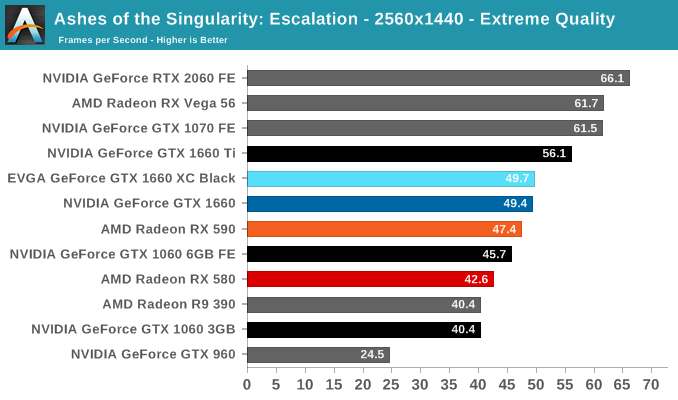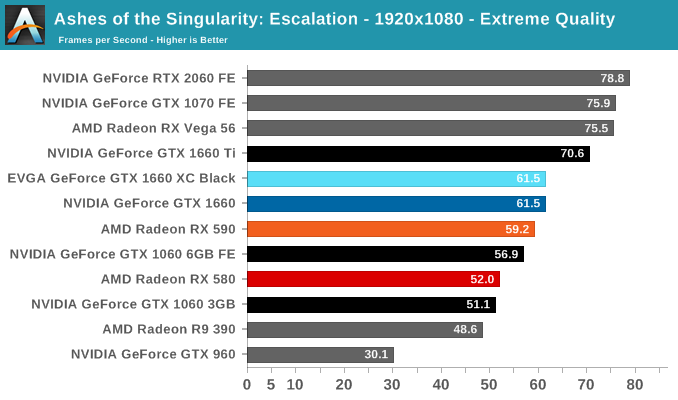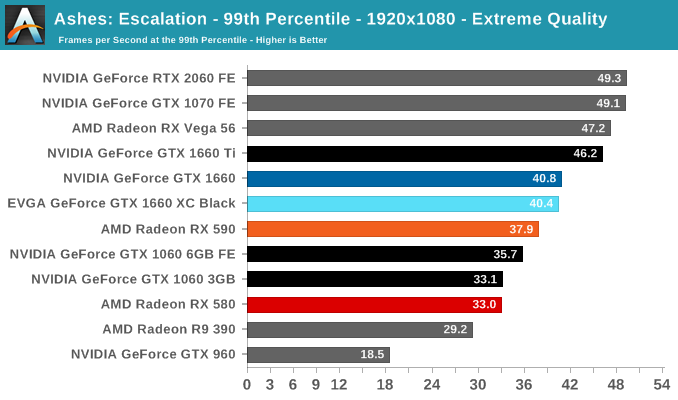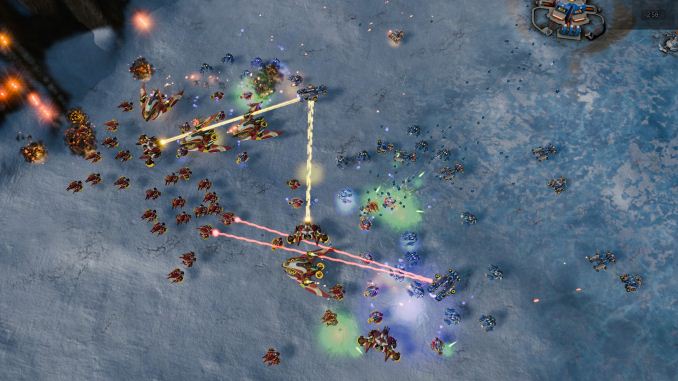The NVIDIA GeForce GTX 1660 Review, Feat. EVGA XC GAMING: Turing Stakes Its Claim at $219
by Ryan Smith & Nate Oh on March 14, 2019 9:01 AM ESTAshes of the Singularity: Escalation (DX12)
A veteran from both our 2016 and 2017 game lists, Ashes of the Singularity: Escalation remains the DirectX 12 trailblazer, with developer Oxide Games tailoring and designing the Nitrous Engine around such low-level APIs. The game makes the most of DX12's key features, from asynchronous compute to multi-threaded work submission and high batch counts. And with full Vulkan support, Ashes provides a good common ground between the forward-looking APIs of today. Its built-in benchmark tool is still one of the most versatile ways of measuring in-game workloads in terms of output data, automation, and analysis; by offering such a tool publicly and as part-and-parcel of the game, it's an example that other developers should take note of.
Settings and methodology remain identical from its usage in the 2016 GPU suite. To note, we are utilizing the original Ashes Extreme graphical preset, which compares to the current one with MSAA dialed down from x4 to x2, as well as adjusting Texture Rank (MipsToRemove in settings.ini).
We've updated some of the benchmark automation and data processing steps, so results may vary at the 1080p mark compared to previous data from last year.




With Ashes, the GTX 1660 edges out the RX 590, but at a decent distance from the GTX 1660 Ti. And like how Ashes offered the least amount of improvement in the suite for the GTX 1660 Ti over the GTX 1060 6GB, this also offers the least amount of improvement for the GTX 1660 over the GTX 1060 6GB and 3GB. Nevertheless, it still slightly outpaces the RX 590.











77 Comments
View All Comments
The_Assimilator - Friday, March 15, 2019 - link
1660 Ti power usage: more for GPU, less for GDDR6. 1660: less for GPU (due to 2 fewer SMs), but more for GDDR5. Hence why overall power usage for both is the same. What I still don't understand is why all of these cards, despite being rated to draw under 150W, come with 8-pin power connectors; 6-pin would make far more sense and would make them compatible with many older systems.Alistair - Friday, March 15, 2019 - link
They are still holding back. This would have been an incredible 7nm card. That's still what I want. Not interested.backpackbrady - Saturday, March 16, 2019 - link
amazing post ryan / nate!@# hoping you could answer a question beyond my knowledge for me. would the 1660 hardware-based encoder nvenc be at a disadvantage with the TU116 and GDDR5 changes? im not sure what effects the encoders performance. thank you very much for your time and knowledge. bradyHrel - Tuesday, March 19, 2019 - link
Suddenly Nvidia's pricing seems completely fair.Supercell99 - Thursday, March 28, 2019 - link
Chinese are done dumping after market GFX cards. Used market is drying upHrel - Saturday, March 30, 2019 - link
This is looking like one hell of a good card for the money and the market. Faster than the RX 580 and RX 590, priced like a cheap 590 or average 580, less power draw, runs cooler, includes Nvidias (frankly) superior software and drivers. So right now either the GTX1070 used, or the GTX 1660 new, 1070 should be about the same price even used. Only cheaper ones I found were crypto mining cards and F that noise.There are some technology differences but idk, you guys don't seem to go into great detail about the differences between GTX 1070 and GTX 1660 excluding game performance. Are there any notable DX features included in the newer card or is it just straight performance improvement?
Hrel - Saturday, March 30, 2019 - link
I think a year or so from now I'll pick one of these up, either 1660 or ti, will depend on then current pricing.